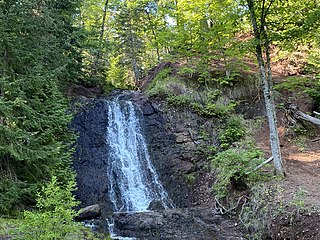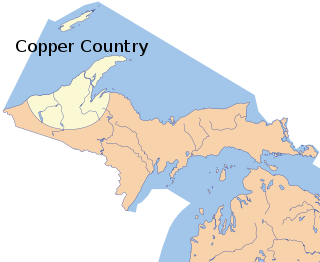
Adams Township is a civil township of Houghton County in the U.S. state of Michigan. As of the 2020 census, the township population was 2,540.

Calumet Charter Township is a charter township of Houghton County in the U.S. state of Michigan. The population was 6,263 at the 2020 census. Even with a decreasing population, the township remains the largest township by population in Houghton County.

Allouez Township is a civil township of Keweenaw County in the U.S. state of Michigan. The population was 1,340 at the 2020 census.

Eagle Harbor Township is a civil township of Keweenaw County in the U.S. state of Michigan. The population was 308 at the 2020 census. The township is located on the Keweenaw Peninsula and also includes the southwestern portion of Isle Royale National Park.

Grant Township is a civil township of Keweenaw County in the U.S. state of Michigan. The population was 275 at the 2020 census. Grant Township is one of the most isolated municipalities in Michigan, as it forms the tip of the Keweenaw Peninsula, which projects into Lake Superior.

The Keweenaw PeninsulaGakiiwe-onigamiing (Ojibwe) ( KEE-wi-naw, sometimes locally ) is the northernmost part of Michigan's Upper Peninsula. It projects into Lake Superior and was the site of the first copper boom in the United States, leading to its moniker of "Copper Country." As of the 2000 census, its population was roughly 43,200. Its major industries are now logging and tourism, as well as jobs related to Michigan Technological University and Finlandia University.

The Copper Country is an area in the Upper Peninsula of Michigan in the United States, including Keweenaw County, Michigan, Houghton, Baraga and Ontonagon counties as well as part of Marquette County. The area is so named as copper mining was prevalent there from 1845 until the late 1960s, with one mine continuing through 1995. In its heyday in the latter half of the 19th century and the early 20th century, the area was the world's greatest producer of copper.

The Keweenaw Waterway is a partly natural, partly artificial waterway which cuts across the Keweenaw Peninsula of Michigan; it separates Copper Island from the mainland. Parts of the waterway are variously known as the Keweenaw Waterway, Portage Canal, Portage Lake Canal, Portage River, Lily Pond, Torch Lake, and Portage Lake. The waterway connects to Lake Superior at its north and south entries, with sections known as Portage Lake and Torch Lake in between. The primary tributary to Portage Lake is the Sturgeon River.

The Quincy Mine is an extensive set of copper mines located near Hancock, Michigan. The mine was owned by the Quincy Mining Company and operated between 1846 and 1945, although some activities continued through the 1970s. The Quincy Mine was known as "Old Reliable," as the Quincy Mine Company paid a dividend to investors every year from 1868 through 1920. The Quincy Mining Company Historic District is a United States National Historic Landmark District; other Quincy Mine properties nearby, including the Quincy Mining Company Stamp Mills, the Quincy Dredge Number Two, and the Quincy Smelter are also historically significant.

In Michigan, copper mining became an important industry in the 19th and early 20th centuries. Its rise marked the start of copper mining as a major industry in the United States. and then

The Cliff mine was the first successful copper mine in the Copper Country of the state of Michigan in the United States. The mine is at the now-abandoned town of Clifton in Keweenaw County. Mining began in 1845, and the Cliff was the most productive copper mine in the United States from 1845 through 1854. Large-scale mining stopped in 1878.

Kearsarge is an unincorporated community in Calumet Township, Houghton County in the U.S. state of Michigan. It is approximately 2 miles (3.2 km) northeast of Calumet/Laurium on U.S. Route 41/M-26 at 47°16′30″N88°24′58″W.
The Michigan Smelter was a copper smelter located at Cole's Creek on the Keweenaw Waterway north-west of Houghton, Michigan near the old Atlantic mill. The smelter was created in 1903-4 as a joint effort between the Copper Range Company and Stanton group of mines. An Atlantic dam on the site was reused by the smelter as a water source. In 1905, the smelter broke a world record by casting 292,000 pounds of fine copper in seven hours with a single furnace and only ten men. The smelter operated through World War II and stopped all operations in 1948.
Arcadian mine was a copper mine developed in 1898 near Paavola, in Franklin Township, a short distance northeast of Hancock, in Houghton County, Michigan. The initial public offering was managed by Boston financier Thomas W. Lawson. The mine was owned and managed by Arcadian Copper Company in which some Standard Oil directors had a significant interest. Although there was a significant amount of investment in the mine, it was not rich in copper. By 1908, the mine was thought to be one of the most spectacular failures in the region. The mine was operated as a tourist destination from the 1950s to the 1970s. In a 2020 interview, Margaret Hamilton recalled her teen years when she worked at Arcadian mine giving tours, and during which time the mine was used to store bananas.
Copper Falls mine was a set of numerous copper mine shafts and adits south of Eagle Harbor, Michigan. The mine was established in 1846. The mine is in Eagle Harbor Township, near the community of Copper Falls and the water fall on the Owl Creek with the same name.
The Atlantic Mine was a copper mine near the Finnish community of Atlantic Mine, Michigan, USA. The mine was operated by Atlantic Mining Company and prospered from 1872-1906.
The Atlantic Mill was located on the east side of Redridge, Michigan near the Redridge Steel Dam. It was constructed in 1892 and closed in 1912. It was connected to the Atlantic mine via a 9 mile long Atlantic and Lake Superior Railroard. The previous path of the railroad is now a scenic tree-covered road. It is thought that currents have moved the stamp sand produced by this mill to the current site of the North Canal Township Park.
The Osceola Mine was a copper mine consisting of 11 shafts located in Osceola Township, Houghton County, Michigan. In 1895, it was the site of the deadliest mine disaster in the Copper Country.
The Mohawk Mining Company was a major copper mining company, based in the Keweenaw Peninsula of Michigan, that was established in November 1898 and lasted until 1932. The company, between 1906 and 1932, paid out more than $15 million in shareholder dividends. The Mine is best known for the large amounts of mohawkite that were found on the property. The Mohawk mine operated until 1932; in 1934 it was purchased by the Copper Range Company.
The Wolverine Mine was a small copper mining operation in the Keweenaw Peninsula of Michigan, that was in operation from January 1882 until November 1884. In August 1890, possession of the company was obtained and reorganized as the Wolverine Copper Mining Company. It mined the Kearsarge lode until 1922 when it closed.












